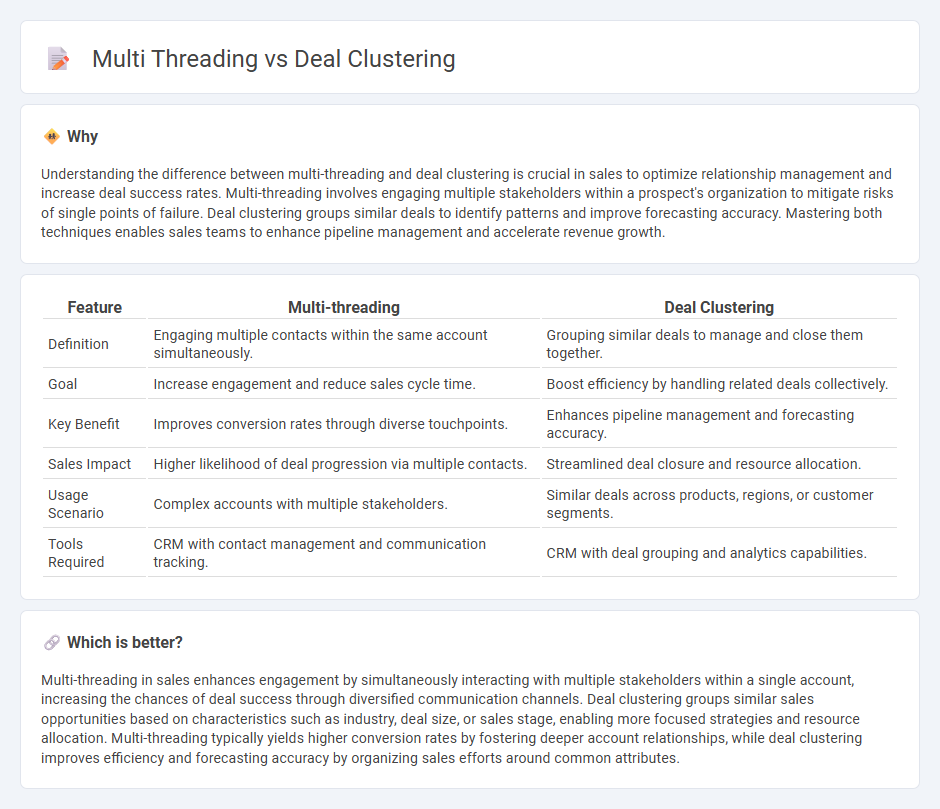
Multi-threading in sales involves engaging multiple stakeholders within a single account to increase the chances of closing a deal by addressing diverse needs and perspectives simultaneously. Deal clustering groups similar sales opportunities based on characteristics such as industry, product interest, or deal size, allowing sales teams to tailor strategies and optimize resource allocation effectively. Explore these techniques to enhance your sales tactics and boost overall revenue performance.
Why it is important
Understanding the difference between multi-threading and deal clustering is crucial in sales to optimize relationship management and increase deal success rates. Multi-threading involves engaging multiple stakeholders within a prospect's organization to mitigate risks of single points of failure. Deal clustering groups similar deals to identify patterns and improve forecasting accuracy. Mastering both techniques enables sales teams to enhance pipeline management and accelerate revenue growth.
Comparison Table
| Feature | Multi-threading | Deal Clustering |
|---|---|---|
| Definition | Engaging multiple contacts within the same account simultaneously. | Grouping similar deals to manage and close them together. |
| Goal | Increase engagement and reduce sales cycle time. | Boost efficiency by handling related deals collectively. |
| Key Benefit | Improves conversion rates through diverse touchpoints. | Enhances pipeline management and forecasting accuracy. |
| Sales Impact | Higher likelihood of deal progression via multiple contacts. | Streamlined deal closure and resource allocation. |
| Usage Scenario | Complex accounts with multiple stakeholders. | Similar deals across products, regions, or customer segments. |
| Tools Required | CRM with contact management and communication tracking. | CRM with deal grouping and analytics capabilities. |
Which is better?
Multi-threading in sales enhances engagement by simultaneously interacting with multiple stakeholders within a single account, increasing the chances of deal success through diversified communication channels. Deal clustering groups similar sales opportunities based on characteristics such as industry, deal size, or sales stage, enabling more focused strategies and resource allocation. Multi-threading typically yields higher conversion rates by fostering deeper account relationships, while deal clustering improves efficiency and forecasting accuracy by organizing sales efforts around common attributes.
Connection
Multi-threading in sales involves engaging multiple contacts within a target organization simultaneously to increase deal velocity and reduce risks of single-threaded relationships. Deal clustering aggregates related sales opportunities by shared attributes such as product lines, customer segments, or buying timelines, enabling more strategic prioritization and resource allocation across these connected deals. Combining multi-threading with deal clustering enhances pipeline management by fostering collaboration across teams while maintaining a holistic view of intertwined sales efforts.
Key Terms
Decision Makers
Deal clustering enhances decision-making efficiency by grouping related deals based on criteria like industry, size, or probability, enabling executives to prioritize opportunities strategically. Multi-threading improves software performance by executing parallel processes, which accelerates data processing but requires technical expertise to implement effectively in decision-support systems. Explore how combining deal clustering with multi-threading can optimize your organization's decision-making processes.
Buying Committees
Deal clustering enhances efficiency by grouping related buying committees based on shared attributes and purchasing behavior, enabling targeted strategies that align closely with organizational needs. Multi-threading improves processing speed and responsiveness in managing simultaneous committee interactions, facilitating real-time collaboration and quicker decision-making. Explore how integrating deal clustering with multi-threading optimizes engagement and accelerates sales cycles in complex buying environments.
Relationship Mapping
Deal clustering efficiently groups related transactions based on shared attributes, enabling clearer relationship mapping between entities. Multi-threading enhances processing speed by executing multiple operations concurrently but requires careful synchronization to maintain data integrity in relationship mappings. Explore how combining deal clustering with multi-threading can optimize complex relationship mapping in large datasets.
Source and External Links
Delta Lake Liquid Clustering - Liquid clustering is an advanced method to optimize data layout in Delta Lake using a tree-based algorithm that balances file size and count to improve query efficiency, featuring incremental updates without recomputing the entire dataset layout.
Approaches to Retail Store Clustering - Retail store clustering groups stores based on metrics like price, sales performance, and capacity to enhance local assortment planning and promotional strategies through multidimensional segmentation.
How Product Clustering Directly Impacts eCommerce Sales? - Product clustering organizes items by shared characteristics, often using machine learning like K-means, to optimize inventory, marketing, and personalization efforts in retail and eCommerce environments.
 dowidth.com
dowidth.com